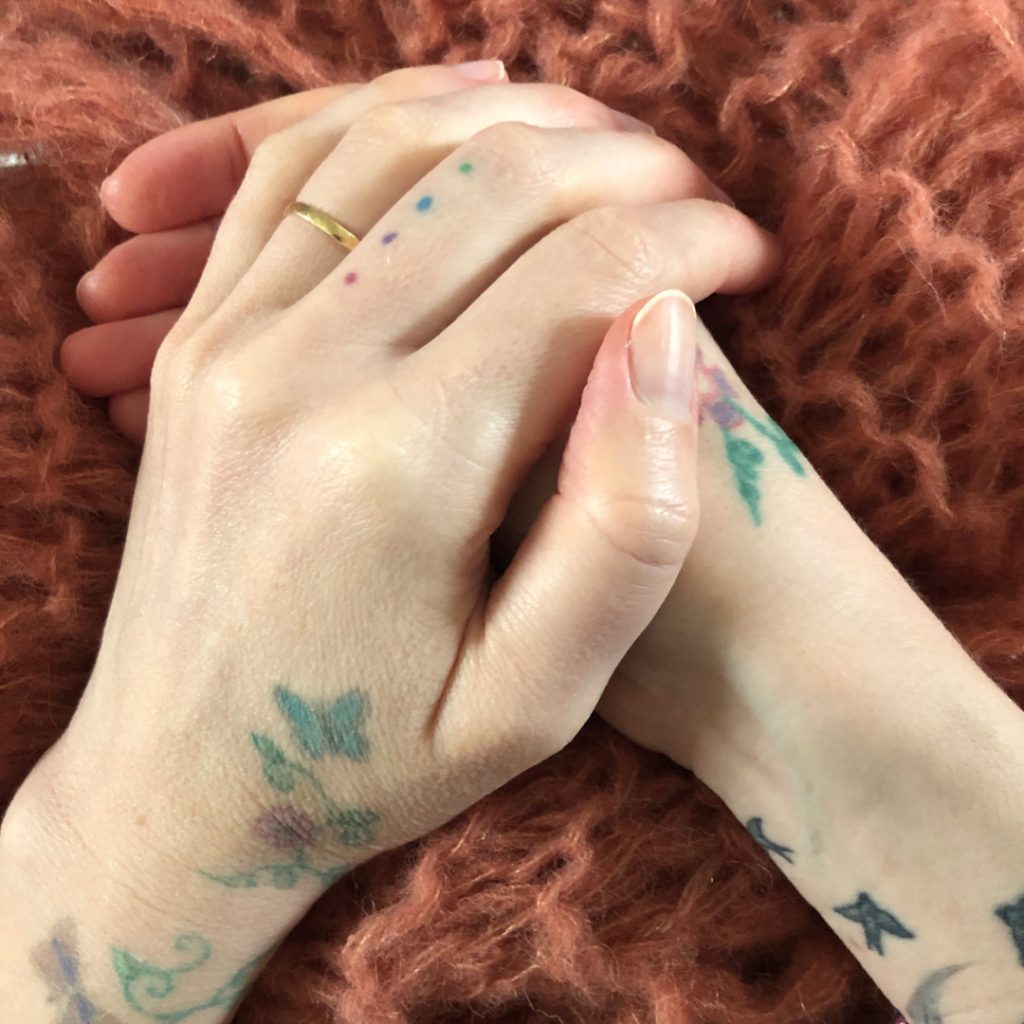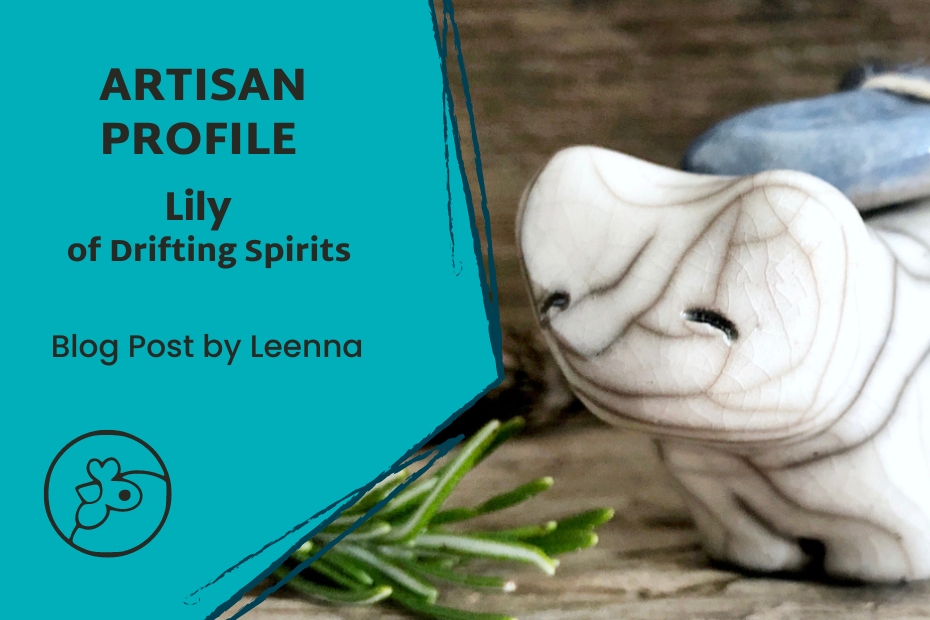This post is part of our Artisan Profiles series, promoting authentic artisans and their products. Artisans: get your store featured by joining our free Buy Handmade campaign. Read the others here.

Meet Lily
You wouldn’t think you’d find serene, playful earth spirits gently lifting your mood as you browse through Drifting Spirits. Call us fanciful, but there’s something beautiful and peaceful about Lily’s ceramic sculptures. Oozing personality, each little sculpture has distinct expressions leaving you with the impression there’s more to them than their beauty.
Then there’s Lily’s ongoing quest of “playing with clay to save the world”. How could we not resist asking them a few questions about their creations and process? After a little research on our part, here’s how the conversation went.

You create Shinto and earth-inspired ceramics to help generate peace in this world. What made you set upon this path? Did it change your journey in producing ceramics, or did it lead to you taking up ceramics? Please share about your journey in ceramics and how it led to your Drifting Spirits store.
I’ve always had a strong desire to try to … save the world really. Not sure how far I’ll get, but I’ve got to try. I’ve also always had very strong spiritual beliefs, and for me those go together somehow. My art and craft, even before I started ceramics, have always been about trying to bring peace and joy back into our reality, trying to encourage people to look beyond the everyday and rediscover both magic and gentleness. I feel that a reconnection to what we’ve lost is essential if we want to turn the train wreck of our current society around. I started ceramics in part as an element of healing from a personal trauma, and it just kind of grew from there. I never expected to be making the types of things I am now, but the more I opened myself to … to the spirits, as daft as that might sound, the more they came through the clay. And of course, my growing in skill helps too: it’s been (and still is) a path of constant learning.

Kami are Japanese Shinto spirits of various places and spaces, if we understand them correctly (please correct us if we’re wrong). Tell us why you’ve chosen Shinto kami (spirits) as your subjects.
I think they’ve almost chosen me. But it’s also because I believe that spirit is present in everything. That’s part of the Shinto tradition but it’s also a part of my native practices; I am a Shinto practitioner but came to it later, and it melds beautifully with traditions from closer to home. To me, each little being I make is the embodiment of a kami and is a spirit who wishes to manifest in this world. Sometimes, their little faces appear in the clay before I’ve even started trying to shape them. I hope that each one can act as a guide, guardian, or just a friend to its new family and, in doing so, help to harmonize and comfort their lives. I do also make slightly more mundane things, but even there: I believe that every piece has a purpose.

Your ceramic process is also Japanese—raku firing. How does this differ from more common methods of finishing a ceramic piece?
My firing is raku, but it’s not Japanese raku. Western raku is a different technique, although it originated from the Japanese method. (I would dearly love to be able to do Japanese raku one day!) But whereas in conventional pottery, the piece is normally fired once, glazed, fired again and allowed to rest in the kiln until it’s cool, my process is a little different. During my glaze firing, I open the kiln at 1000°C. Everything is white-orange and glowing; I have wool and leather gloves that go up to my elbows! I remove each piece individually with a very long pair of forged steel tongs and place it into a galvanized metal container filled with wood shavings (or hemp, flax, etc.). The wood shavings ignite, and I rush, while trying not to rush, to get all the pieces in. Then I cover everything with more wood shavings and put the lid on the container, as raku requires a reduction environment with as little oxygen as possible. After a few hours, I remove the sculptures, and once they’re completely cool, I scrub off the sticky black residue left by the fire (one of my least favorite parts of the whole process). Then they’re done! Assuming, that is, that the pieces don’t crack from the thermal shock and the glaze doesn’t hate me that day.

Let’s talk clay and glazes. What would you like us to know about your raw materials?
Raku is a pain! To get the effects I want (crackling, translucency, brushability of the wet glaze), I use a combination of minerals in my glaze recipes which includes an extremely temperamental one. I’ve mostly learned (after lots of trial and error and plenty of misfits to show for it) to cater to its needs, but I really never know whether or not it’s happy with me until I pull the sculptures out at the end. That mineral is also in limited supply, so I’m glad I make small things.
On a more mundane note, I use a grogged stoneware clay. This means it has tiny mineral particles in it; these help the body of the sculptures be more resistant to the thermal shock of the raku firing. At present, my clay is Spanish, so not from too far away.

Your works are extremely whimsical and deceptively simple in appearance, yet each spirit has a different expression and personality despite their size and similarities in shape. How do you achieve this individual uniqueness—divine inspiration, creative process, or something else?
Thank you! Ha and I’m glad you said deceptively simple. Really though I think it’s because each one truly is an individual. I can sometimes spend significant time on their faces, simple though those faces are, just because an eye or a mouth in the “wrong” place can throw off the whole character of the piece. Often I just have to stop and listen to the sculpture—by that point fully formed—and hear what it’s trying to tell me, how it wants to look. Sometimes I’m not sure, but I go with it anyway, and then I remember that glazing does subtly change facial character and figure the sculptures know what they want.

What is your favorite part of creating your earthy works?
There are two parts really. The first is seeing them scrubbed, in all their glorious colors. I studied color theory as part of my life before ceramics, and so color harmony is extremely important to me. The second is when someone or something I never expected, but that I really like, suddenly appears in my hands. I feel very blessed then to be a part not only of the spirit’s journey, but of its eventual family’s journey too.
With your home in France, what made you join the Artisans Cooperative? What does being a member of the Coop mean to you?
I’ve been an Etsy seller for a long time, on and off, both for Drifting Spirits and for a previous craft business. I’ve seen it decline, seen the lives and business ruined by the effusion of corporate greed and capitalism that has become its standard procedure. We desperately need more fair and equitable everything in this world—a more human and humane way of being—so the Coop seemed a natural choice for me.
Being a member means being a part of something new, but also of something old: community and mutual support have existed for far longer than our current economic and social models, and I’m honored to be a part of their revival.

Any advice for those wishing to help generate or spread peace in this world through art, or for ceramics artisans in general?
Things are so bad right now that it’s hard for me to sit here and say make cute things and spread joy. I myself have been heavily involved with politics, environmentalism, and various other activisty pursuits, so it’s not like I just commune with the spirits and think it’ll all be fine. (If only!) But equally, we need beauty. We need harmony and peace, kindness and depth. So if your art spreads a message of peace and acceptance, please make more of it. And share it wherever you can. Make cute things if that’s what drives you, but make them with meaning. It’s somewhat of a cliché, but the ripples in the pond idea is one that still resonates with me: every action you take for good, however small, will spread out and get bigger.
As for advice for ceramic artists, don’t do raku unless you love stress! Seriously though, make what you love and what brings you joy. That joy will shine through your pieces and into the lives of everyone who buys them.
Lily, Drifting Spirits
Shop Lily’s beautiful and peaceful ceramic sculptures on the Artisans Cooperative marketplace: Drifting Spirits Art >>>
About Artisans Cooperative
We are growing an online handmade marketplace for an inclusive network of creatives: a co-op alternative to Etsy.
Shop the marketplace!

What a lovely interview. So good to know more about the spirit behind Drifting Spirits, and the challenging process that produces her gentle creations.
Thank you, Judith. It was such a pleasure to work on this interview.
So glad you enjoyed it.
This was such a nice read!
Thanks Nicole! It was such a pleasure to learn about Lily’s process, too!